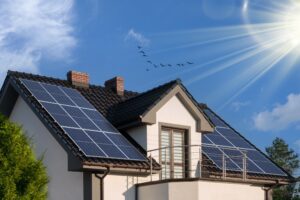Have you ever wondered why the majority of solar panels are black or blue? These colours aren’t artificially incorporated into solar modules for aesthetic effect, rather they are a result of how the panels are manufactured.
So why are we seeing black rooftop solar panels becoming more commonplace than blue ones? In this post, you can find out all about the increasing use of black solar panels, including pros and cons, and costs.
- Create a Tailored Quote Based On Your Circumstances
- Takes Less Than 2 Minutes
- Fixed-Online Quotes

What Affects the Colour of Solar Panels?
Traditionally, solar panels had a shiny blue appearance. These panels are made with polycrystalline solar cells.
The blue appearance is due to an anti-reflective layer added to the panels to optimise light absorption and power output. However, blue solar panels are still not as energy efficient as black solar panels, and this is why solar arrays installed nowadays are mainly black.
Black solar panels are made with monocrystalline solar cells, whose greyish colour darkens during the manufacturing process.
Besides the solar silicon cells themselves, the overall look of solar panels is also determined by the type of frame and backsheet.
Solar Panel Frames and Backsheets
The solar panel frame holds the various components together, protecting them from the elements. The backing sheet provides additional protection for solar cells.
Solar panel frames are usually made with aluminium, which is naturally a silvery-white colour, though they can also be designed to be black. Solar panel backing sheets can be black or white.
Types of Black Solar Panels
The cheapest solar panels have silver frames, which are conspicuous, and white backing sheets that are visible between the solar cells. But solar panel frames and backsheets can be configured to produce monocrystalline panels that are mostly black or entirely black.
Black Frame with a White Backsheet
Solar panel manufacturers and installers are now offering black frames in response to public demand. Colouring the frame black gives solar panels a more discreet look that’s often the preferred choice for contemporary homes in suburban locations.
However, a white backing sheet remains visible between the solar cells, giving something of a chessboard appearance. However, white backsheets improve solar performance by reflecting sunlight back into the solar cells.
Black Frame with a Black Backsheet
All-black solar panels use a black backing sheet with a black frame. This gives the panels a sleeker look but reduces efficiency slightly because they capture less light.
Nevertheless, the monocrystalline solar cells are more efficient than polycrystalline panels, and all-black panels are overall only 0.5% less efficient. The only major difference between all-black panels and panels with a white backsheet is the aesthetic.
- Create a Tailored Quote Based On Your Circumstances
- Takes Less Than 2 Minutes
- Fixed-Online Quotes

Advantages of Black Solar Panels
Monocrystalline solar panels with black frames and black or white backing sheets hold advantages over blue, polycrystalline panels in terms of efficiency, lifespan, visual appeal, and heat resistance.
More Energy Efficiency
Energy efficiency of a solar panel is measured by how much light it turns into electricity. Higher energy efficiency is the most important benefit of black solar panels. The high-grade, pure silicon of monocrystalline cells in black solar panels are around 24% energy efficient, compared with 15 to 20% efficiency of blue panels.
Black solar panels also typically perform better in shaded areas and in overcast or cloudy weather because they are more efficient at capturing diffuse light. This results in higher energy output compared with blue solar panels in similar conditions.
Longer Lifespan
Black solar panels have a longer lifespan than blue panels because their monocrystalline cell structure is less susceptible to breakdown. Black solar panels can last 30 to 40 years or longer, compared with the average 20 to 25 years of blue solar panels.
Enhanced Visual Appeal
Many homeowners believe the sleek look of black solar panels is more stylish and visually attractive than blue panels. Black solar panels tend to blend in better with surrounding roof tiles, particular on darker-coloured roofs.
Greater Heat Resistance
Black solar panels are more heat resistant than blue panels. This is becoming increasingly important as climate change drives higher temperatures that can reduce solar cell power output by 10 to 25%.
Disadvantages of Black Solar Panels
Although black, monocrystalline solar panels offer several benefits compared with blue, polycrystalline panels, they also have drawbacks when it comes to cost and the manufacturing process.
Higher Installation Cost
The main disadvantage of using black solar panels is the price. Installation costs for black solar panels average £370 to £450 per square metre, compared with £300 to £350 for blue solar panels.
However, the lower price of blue solar panels comes at the cost of inferior efficiency. You’ll need sufficient roof space to install more blue solar panels to get the same amount of electricity.
And savings on energy bills will be less because you’ll be relying more on the national grid. This means it takes longer to see a return on your investment.
Greater Environmental Impact
Manufacturing black solar panels is less eco-friendly than the production of blue solar panels. Making monocrystalline solar cells results in silicon wastage that can’t be repurposed to make other black solar panels.
The production of blue solar panels also requires less energy and emits fewer greenhouse gases.
Do Solar Panels Come in Other Colours?
Dyes and colour coatings can be used to produce solar panels in shades other than black and blue.
These solar arrays are becoming increasingly common in some parts of Europe and the United States, but they cost more to make and their availability in the UK is generally limited to specialist solar panel manufacturers and installers.
This is because the vast majority of UK homeowners go solar to reduce energy costs. So the potential aesthetic benefit of making solar panels available in a range of colour options is cost prohibitive.
The fact that solar panels are predominantly black or blue has nothing to do with aesthetic preferences of the manufacturers. These colours are the result of the silicon solar cell production process. However, solar technology is constantly advancing, and this could lead to a wider range of less costly solar panel colours in the future.
Choosing Between Black Solar Panels and Blue Solar Panels
The choice between black solar panels and blue solar panels comes down to your priorities, budget, aesthetic preferences, and energy requirements. Black panels cost more but offer a sleek appearance and provide better energy efficiency, which saves more money on electricity bills.
Blue panels are cheaper but less efficient, and some people are put off by the visual impact of their shimmering appearance.If you have a limited budget and plenty of roof space, blue solar panels could be a good choice.
On the other hand, black solar panels may be right for you if:
- Cost isn’t a primary concern.
- Installation space is limited.
- You’re looking for high energy efficiency.
- You prefer the visual appeal of black solar panels.
How to Make Going Solar More Affordable
If you want to install black solar panels but are concerned about the extra cost, there are ways to make them more affordable. These include free site surveys and quotes, and spreading the cost with a finance package. Contact Effective Home if you’d like to take advantage of these options.
Bear in mind there’ll be no VAT charges on solar panel installation until March 2027 so there has never been a better time to go solar than now.
- Create a Tailored Quote Based On Your Circumstances
- Takes Less Than 2 Minutes
- Fixed-Online Quotes




